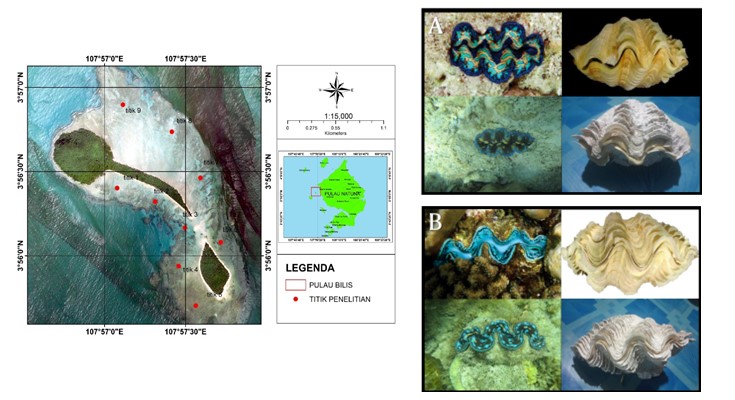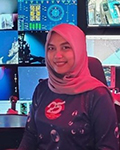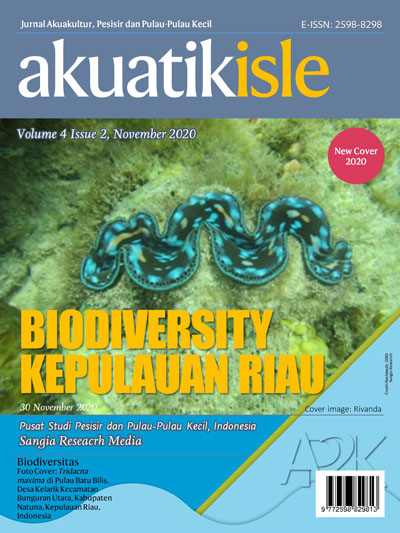Akuatikisle: Jurnal Akuakultur, Pesisir dan Pulau-Pulau Kecil
Full Length Article
Inventory of clams Tridacnidae in Batu Bilis Island, Kelarik Village Bunguran Utara District, Natuna Regency, Riau Islands, Indonesia
Inventarisasi kima (Tridacnidae) di Pulau Batu Bilis, Desa Kelarik Kecamatan Bunguran Utara, Kabupaten Natuna, Kepulauan Riau, Indonesia
Highlights
Generate NLP AI by Wizdam ID.
Abstract
Pulau Batu Bilis Desa Kelarik dikelilingi oleh hamparan terumbu karang yang dangkal dengan tingkat kecerahan air yang cukup cerah, sehingga menjadi habitat bagi biota–biota ekonomis penting berupa kerang kima (Tridacnidae). Tujuan penelitian adalah untuk mengidentifikasi jenis kima dan mengetahui nilai kepadatan kima. Pengambilan data kima dilakukan pada 9 (sembilan) titik. Menggunakan metode Benthos Belt Transect, dengan luasan area pengamatan 140 m². Hasil penelitian dijumpai 2 (dua) jenis kima, yaitu Kima Lubang (Tridacna crocea) dan Kima Kecil (Tridacna maxima). Kepadatan tertinggi Kima Lubang terdapat pada titik 9 (sembilan) dengan nilai 1.142,9 individu/ha, kemudian kepadatan terendah pada titik 7 (tujuh) 142,86 individu/ha. Kepadatan tertinggi Kima Kecil terdapat pada titik 7 (tujuh) dengan nilai kepadatan 928,57 individu/ha dan kepadatan terendah pada titik 8 (delapan) dengan nilai 71,43 individu/ha. Kualitas parameter fisika–kimia pada perairan Batu Bilis masih dalam kisaran normal untuk kehidupan kima seperti suhu 29,4⁰C, salinitas 29,5‰, kecepatan arus 0,08 m/s dan kecerahan 100%.
Abstract
Batu Bilis Island Kelarik Village is surrounded by shallow coral reefs with a fairly bright level of water brightness, making it a habitat for important economic biota in the form of clam shells (Tridacnidae). The purpose of this study is to identify the types of clam shells and determine the value of shellfish. Closing data is carried out on 9 (nine) points. Using the Benthos Belt Transect method, with an observation area of 140 m². The results were found 2 (two) types of clams, namely Hole Clams (Tridacna crocea) and Small Clams (Tridacna maxima). The highest density of Hole Clams is at point 9 (nine) with a value of 1.142.9 individual/ha, then the lowest density at point 7 (seven) 142,86 individual/ha. The highest density of Small Clams is at point 7 (seven) with a density value of 928,57 individual/ha and the lowest density at point 8 (eight) with a value of 71,43 individual/ha. The quality of physical-chemical parameters in Batu Bilis waters is still in the normal range for the life of clams shells such as temperature 29,4⁰C, salinity 29,5‰, current speed 0,08 m/s and brightness 100%.
Keywords
Introduction
Section snippets
Material and Methods
Materials and methods from the full-text PDF of this article cannot be displayed.
Results
Results from the full-text PDF of this article cannot be displayed.
Discussion
Discussion from the full-text PDF of this article cannot be displayed.
Conclusions
Conclusions from the full-text PDF of this article cannot be displayed.
Acknowledgment
Acknowledgment from the full-text PDF of this article cannot be displayed.
Funding Information
Fakultas Ilmu Kelautan dan Perikanan, Universitas Maritim Raha Ali Haji, Indonesia
Competing interest
The authors declare that they have no known competing financial interests or personal relationships that could have appeared to influence the work reported in this paper.
Conflict of interest
The authors declare that the research was conducted in the absence of any commercial or financial relationships that could be construed as a potential conflict of interest.
Ethical approval acknowledgements
No ethical approval required for this article. All procedures followed were in accordance with the ethical standards of the responsible committee on human experimentation (institutional and national) and with the Helsinki Declaration of 1975, as revised in 2008 (5)
Data availability
All the data have been provided via Supplementary files. Any further information can be requested from the corresponding author via email upon reasonable request.
Appendix. Supplementary materials
Supplementary File 1: INVENTARISASI KIMA (TRIDACNIDAE) di PULAU BATU BILIS DESA KELARIK KECAMATAN BUNGURAN UTARA KABUPATEN NATUNA (Research Results)
Owner: ¹Rivanda, ²Susiana, ³Dedy Kurniawan
Sponsor -
Publisher -
1. Jenis kima yang dijumpai pada perairan Pulau Batu Bilis sebanyak 2 jenis 1 genus dan 1 family yaitu Kima Lubang (Tridacna crocea) dan Kima Kecil (Tridacna maxima).
2. Kepadatan tertinggi Kima Lubang terdapat pada titik 9 (sembilan) dengan nilai 1.142,9 ind/ha² kemudian kepadatan terendah pada titik 7 (tujuh) dengan nilai 142,86 ind/ha², Kepadatan tertinggi Kima Kecil terdapat pada titik 7 (tujuh) dengan nilai kepadatan 928,57 ind/ha² dan kepadatan terendah pada titik 8 (delapan) dengan nilai 71,43 ind/ha².
Declarations information
License and permission
 This work is licensed under a Creative Commons Attribution-ShareAlike 4.0 International License (https://creativecommons.org/licenses/by-sa/4.0), which permits use, sharing, adaptation, distribution and reproduction in any medium or format, as long as you give appropriate credit to the original author(s) and the source, provide a link to the Creative Commons licence, and indicate if changes were made. The images or other third party material in this article are included in the article's Creative Commons licence, unless indicated otherwise in a credit line to the material. If material is not included in the article's Creative Commons licence and your intended use is not permitted by statutory regulation or exceeds the permitted use, you will need to obtain permission directly from the copyright holder.
This work is licensed under a Creative Commons Attribution-ShareAlike 4.0 International License (https://creativecommons.org/licenses/by-sa/4.0), which permits use, sharing, adaptation, distribution and reproduction in any medium or format, as long as you give appropriate credit to the original author(s) and the source, provide a link to the Creative Commons licence, and indicate if changes were made. The images or other third party material in this article are included in the article's Creative Commons licence, unless indicated otherwise in a credit line to the material. If material is not included in the article's Creative Commons licence and your intended use is not permitted by statutory regulation or exceeds the permitted use, you will need to obtain permission directly from the copyright holder.
Publisher's Note
Sangia Publishing remains neutral with regard to jurisdictional claims in published maps and institutional affiliations.
References (1)
Ambariyanto. 2007. Pengelolaan Kima di Indonesia: Menuju Budidaya Berbasis Konservasi. Seminar Nasional Moluska: dalam Penelitian, Konservasi dan Ekonomi Jurusan Ilmu Kelautan, FIKP UNDIP, Semarang, 17 Juli 2007.
Cappenberg, H.A.W., 2007. Sebaran dan Kepadatan Kima (Tridacnidae) di Perairan Derawan, Kalimantan Timur. Jurnal Perikanan. 9(2): 220-225.
Cappenberg, H. A. 2017. Inventory and Distribution of Mollusc in Coral Reef of Bacan Island Waters, North Maluku Province. Jurnal Ilmu dan Teknologi Kelautan Tropis, 9(1): 265-280.
Eliata, A.F., Zahida, N.J., Wibowo, & Panggabean, L.M.G. 2003. Kelimpahan Kerang Raksasa dalam Ekosistem Terumbu Karang di Pulau Pari: Perbandingan Populasi Tahun 2003 dengan Data Tahun 1984. Jurnal Biota. 8(3): 149-152.
Fachrul M.F. 2007. Metode Sampling Bioekologi. PT Bumi Aksara. Jakarta.
Giyanto, Manuputty, A.E.W., Abrar, M., Siringoringo, R.M., Suharti, S.R., Wibowo, K., Edrus, I.N., Arbi, U.Y., Cappenberg, H.A.W., Sihaloho, H.F., Tuti, Y., Zulfianita, D. 2014. Panduan Monitoring Kesehatan Terumbu Karang. CRITC COREMAP CTI LIPI. Jakarta.
Hernawan, U.E. 2011. Taksonomi Kerang Raksasa Indonesia. Kawasan Konservasi Biotik Laut Tual. Jurnal Biodiversitas. 13(3): 118-123.
Ode, I. 2007. Kepadatan dan Pola Distribusi Kerang Kima (Tridacnidae) di Perairan Teluk Nitanghai Desa Morella Maluku Tengah. Agrikan: Jurnal Agribisnis Perikanan. 10(2):1-6.
Klumpp, D.W., & Griffiths C.L. 1994. Kontribusi Nutrisi Fototrofik dan Heterotrofik Terhadap Kebutuhan Metabolisme dan Pertumbuhan Empat Kerang Raksasa (Tridacnidae). Jurnal Seri Kemajuan Ekologi Kelautan. 115: 103-115.
Marsuki, I.D., Sadarun, B., & Palupi R.D. 2013. Kondisi Terumbu karang dan Kelimpahan Kima di Perairan Pulau Indo. Jurnal Mina Laut Indonesia, 01(01): 61-72.
Marianingsih, P., Amelia, E., & Suroto, T. 2013. Inventarisasi dan Identifikasi Makroalga di Perairan Pulau Untung Jawa. Jurnal Prosiding Semirata FMIPA Universitas Lampung. 1(1): 219-225.
Munro, C. 2013. Diving. Methods for the Study of Marine Benthos (ed. by A. Eleftheriou), John Wiley, Sons, Ltd.
Miala, I., Pratomo, A., & Irawan, H. 2015. Hubungan Antara Bulu Babi, Makroalga dan Karang di Perairan Daerah Pulau Pucung. Repository UMRAH. Tanjungpinang.
Padilah, M., Pratomo, A., & Zulfikar, A. 2015. Pola Sebaran Kima (Tridacnidae) di Desa Malang Rapat Kecamatan Gunung Kijang Kabupaten Bintan Kepulauan Riau. Repository UMRAH. Tanjungpinang.
Saputra, A., Karlina, I., & Putra, R.D. 2016. Pola Sebaran Kima di Perairan Laut Pulau Berhala Kecamatan Jemaja Kabupaten Kepulauan Anambas Provinsi Kepulauan Riau. Repository UMRAH. Tanjungpinang.
Setiawan, H. 2013. Ancaman Terhadap Populasi Kima (Tridacnidae sp.) dan Upaya Konservasinya di Taman Nasional Taka Bonerate, Jurnal Info Teknis Eboni. 10(2): 137-147.
Susiana, S., Niartiningsih, A., & Amran, M. A. 2013. Kelimpahan dan kepadatan kima (Tridacnidae) di Kepulauan Spermonde. Agrikan: Jurnal Agribisnis Perikanan, 6: 55-61.
Susiana, Niartiningsih, A., & Amran, M.A. 2014. Hubungan Antara Kesesuaian Kualitas Perairan dan Kelimpahan Kima Tridacnidae di Kepulauan Spermonde. Jurnal. Fakultas Ilmu Kelautan dan Perikanan Universitas Hasanuddin: Makassar. 9(2): 475-490.
Susiana, Niartiningsih, A., Amran, M.A., & Rochmady, R. 2017. Kesesuaian Lokasi Untuk Restoking Kima Tridacnidae di Kepulauan Spermonde. Jurnal Ilmu dan Teknologi Kelautan Tropis. 9(2): 475-490.
Suryanto, H., Yulianda, F., & Wardiatno, Y. 2009. Analisis Status Terumbu Karang Untuk Pengembangan Wisata Bahari Di Desa Teluk Buton Kabupaten Natuna. Jurnal Ilmu-Ilmu Perairan dan Perikanan Indonesia, 16(2): 137-143.
Wakum, A., Takdir, M., & Talakua, S. 2017. Jenis-Jenis Kima dan Kelimpahannya di Perairan Amdui Distrik Batanta Selatan Kabupaten Raja Ampat. Jurnal Sumberdaya Akuatik Indopasifik. 1(1): 43-52.
Bibliographic Information
Cite this article as:
-
Submitted
13 January 2020 -
Revised
22 May 2020 -
Accepted
10 June 2020 -
Published
17 October 2020 -
Version of record
25 May 2023 -
Issue date
30 November 2020
-
Academic subject
Fisheries; Fisheries Science
Copyright
Sangia Advertisement
Kepulauan Riau has enormous potential for marine resources. Marine biological resources ranging from mangroves, fish, shellfish, coral, and much more. However, behind such great wealth, there are also management challenges. Susiana and colleagues inventory potential resources of Tridacnidae clams in Riau Islands, Indonesia. See Rivanda et al.
Copyright © 2020 Rivanda Rivanda, Susiana Susiana, & Dedy Kurniawan. Sangia Research Media and Publishing. Production and hosting by Sangia (SRM™).  This work is licensed under a Creative Commons Attribution-ShareAlike 4.0 International License.
This work is licensed under a Creative Commons Attribution-ShareAlike 4.0 International License.
Disclaimer: All claims expressed in this article are solely those of the authors and do not necessarily represent those of their affiliated organizations, or those of the publisher, the editors and the reviewers. Any product that may be evaluated in this article or claim that may be made by its manufacturer is not guaranteed or endorsed by the publisher.
Comments on this article
By submitting a comment you agree to abide by our Terms and Community Guidelines. If you find something abusive or that does not comply with our terms or guidelines please flag it as inappropriate.











